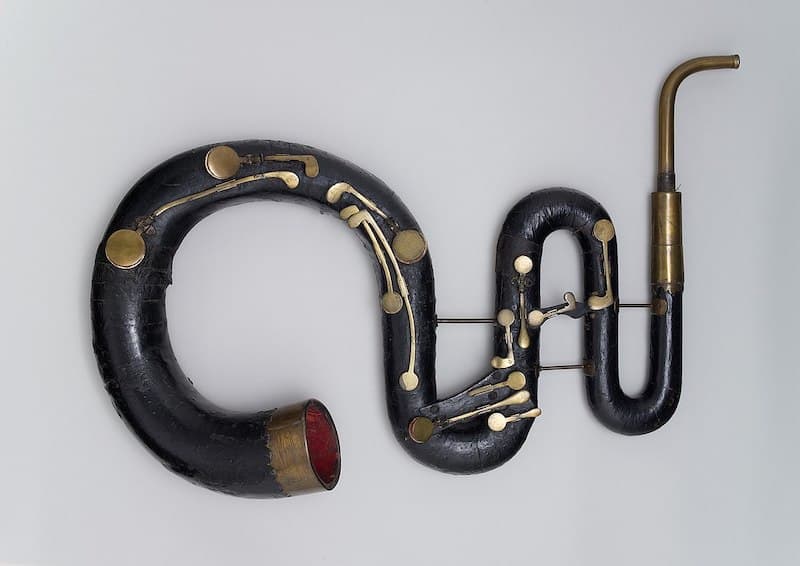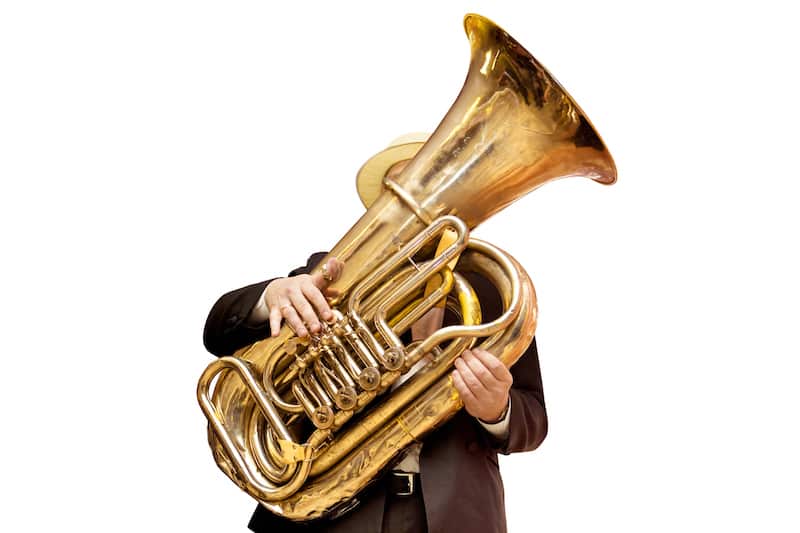The tuba is a low-pitched instrument that gained popularity in the 19th century. Since then, the tuba has become a vital instrument in orchestras, marching bands, and military ensembles. Even jazz players use the tuba for its distinctively deep, enveloping sound. So, what is it that makes the tuba so captivating to the audiences?
In this article, we’ll go over 15 interesting facts about the tuba. Let’s have a look!
1. The Tuba’s Ancestor Was Called the Serpent

The tuba went through a lot of changes before reaching its final form. Its structure is mainly influenced by an earlier instrument called the serpent.
The serpent appeared in the 18th century and is regarded as the distant ancestor of today’s tuba. It was made of wood and had holes instead of valves.
The earliest version of the tuba had a curvy wooden pipe that looked like a serpent.
It was quickly replaced with the ophicleide, which looks more like a modern tuba than a serpent.
2. Tubas Can Vary in Size
If you were to picture what a tuba looked like right now, most people will probably think of a 3/4 or 4/4 sized tuba.
In reality, tubas come in a wide variety of sizes.
But, the numbers 3/4 and 4/4 don’t mean a three quartered size or full-size tuba. The number denoted next to the instrument indicates the width of the tubing sections.
This doesn’t change the fundamental pitch of the instrument, but rather the loudness of the sound.
Tubas are also manufactured in various lengths. The longer the tuba, the lower the pitch.
- The smallest tuba is the 3/4 tuba. (It’s commonly used in schools where the students can appreciate the lighter weight.)
- 4/4 tubas are considered the standard size.
- 5/4 tubas are known as kaiser tubas and are a little bigger.
- 6/4 tubas are referred to as grand orchestra tubas.
Some of the most prominent grand orchestra tubas are the Hirsbrunner HB-50 and the 1930s Conn 36K Grand Base.
This takes us to the next fun fact.
3. Tubas Are Extremely Heavy!

Tubas can be cumbersome to carry; they weigh around 30 lbs! Some tubas can reach over 50 lbs.
This is why people play the tuba sitting down. A chair allows the player to sit in an upright position, which provides them with the breath support they need.
Even marching bands usually use a lighter version of the tuba, called the sousaphone.
Children usually play on 3/4 tubas to better accommodate the weight.
4. Some Tubas Can be Converted Into Different Variations
Convertible tubas are also known as marching tubas. This involves manually screwing a leadpipe near the valves and resting the tuba on your left shoulder.
The bell will be facing the audience and its back will be facing you.
Some manufacturers provide harnesses that give the player more support while standing up.
5. Players Need to Make a Buzzing Sound
Anyone who’s never played the tuba before will assume they should just blow air into the mouthpiece.
This isn’t entirely true.
To produce the distinctive voice of the tuba, you need two things: air and vibration.
You can do this by placing your lips against the mouthpiece and saying the syllables “OH” and “OO.”
When you blow into the mouthpiece, make sure there’s no space between your lips and the mouthpiece.
This will cause your lips to vibrate and for the correct tone to be heard.
7. Tubas Vary in Pitches, Valves, and Finish
We’ve already covered how tubas come in various sizes, from 3/4 up to 6.4, but that’s not where the differences end! Tubas can also come in different pitches.
There are tubas in the key of Bb, F, Eb, and many more.
The lowest-pitched tuba is called the subcontrabass tuba. It’s extremely rare and hardly ever used today.
It was used in the 1950s for comedic festivals and then shortly disappeared.
Other types of tubas include contrabass tubas, tenor tubas, and bass tubas.
There’s no real standard when it comes to the number of valves on the instrument.
Beginner and cheap tubas have three valves, most other tubas have four. Some bigger, more expensive, tubas have six.
Finally, all tubas are made from brass, but they could be electroplated, lacquered, finished with nickel, silver, or gold, or left unfinished.
8. Some Early Tubas Had Front-facing Bells
There were two versions of the early tuba: the concert tuba and the recording tuba.
The concert tuba looked like the modern tuba, but the recording tuba was made to make recording easier.
Since the concert tuba had back-facing bells, recording the sounds was awkward.
This is why recording tubas were invented. Same structure, same size, different bell placement.
The forward-facing bells enabled musicians to record the sounds in a more convenient way.
Nowadays, there are convertible tubas that can change into recording tubas.
9. The Tuba Was Mainly Popularized by Clever Marketing
There’s no denying that the tuba is one of the most sophisticated instruments in the brass family.
However, there were a lot of equally impressive instruments that preceded the tuba.
So, how did the tuba trump instruments like the ophicleide? Clever marketing techniques.
You could argue that the ophicleide was much harder to play than the tuba, but a lot of musicians disagree.
It’s thought that the tuba was marketed as the easier instrument to play, with some additional bells and whistles that attracted the audiences.
10. The Tuba Isn’t Just a Backup Instrument
Tubas aren’t just bass instruments that support the main performance.
Throughout history, the tuba has been involved in numerous concertos as the featured instrument.
Symphonists like John Williams and Ralph Vaughan Williams frequently incorporated this instrument in their compositions.
The tuba becomes more prominent during marching bands, where there is usually more than one.
Street performances greatly benefit from the loud bass sound, which is why tubas are an essential component of any brass ensemble.
11. The Tuba can be Played as a Solo Instrument
Here’s a common myth about tubas: their deep and rich tones make them unsuitable for solo performances. This is surprisingly untrue.
Tubas have been involved in many solo compositions and albums.
Concertos like Fredrik Hogberg and Roger Bobo have created masterpieces that are mainly centered on the tuba.
12. The Tuba Has the Lowest Pitch in the Brass Family
The subcontrabass tuba is officially the lowest-pitch instrument in the brass family.
Tubas, in general, were intended to be distinctively low-pitched.
The first version of the tuba in the 1830s was so low-pitched that it wasn’t a success.
It wasn’t until the late 1800s when other iterations started to surface, and the potential of the tuba was finally realized.
13. Orchestras Can Request an Additional Tuba
It may surprise you, but some orchestras use two or more tubas in their performances. It’s not common and usually involves two different types of tubas.
However, huge performances may also require additional tubas to boost the sound.
Remember, a tuba in an orchestra is like the subwoofer in your sound system.
Two tubas would require around 30 violins to keep the sound balanced.
Interestingly, over 7500 musicians assembled in Frankfurt and carried out the largest orchestra performance in the world!
Can you imagine how many tubas there were?
14. Tubas can be Used in Most Types of Music
When we think of a tuba, we either picture a marching band or an orchestra. In reality, tubas are used in a wide variety of music types.
From jazz bands to pop groups, tubas are surprisingly versatile for their distinctive tone.
They’re used to reinforce the bass sound and add more depth to the performance.
Louis Armstrong used the tuba frequently during his career.
Stan Kenton, one of the most influential musicians of modern jazz, used tubas in many of his jazz compositions.
The list goes on.
15. Jazz Bands Used Tubas to Perform Outdoors
Jazz bands use a string instrument called the double bass for most performances.
It’s made from wood and usually isn’t very tolerant to water and humidity.
Since a double bass wouldn’t survive bad weather, early jazz players started using the tuba instead.
In Conclusion
It’s one of life’s greatest ironies that the tuba is the loudest instrument in the orchestra, yet is hardly heard over the main performance.
The tuba is a modern instrument that quickly appealed to the crowd.
From its inception in the 1800s till today, the tuba has had quite a journey!

